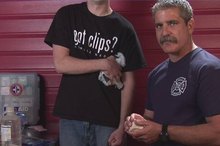When I Stretch My Rib Hurts
If your ribs hurt while stretching, you’ve likely experienced a recent traumatic blow to the chest or have been lifting more weight than your muscles can handle. Some rib injuries are potentially life-threatening, since the ribs protect vital organs, so always consult with your doctor if you’re feeling rib pain.
Identification
The symptoms of your rib pain while stretching will vary depending on the injury. If a rib is broken or cracked, it will hurt to take deep breaths. If you place your finger on the rib, it will be tender and you may hear a crunching sound if you try moving the bone. Your ribs may look deformed. Any stretching or twisting movements of the spine and abs will cause pain to the ribs. A muscle strain can be mild, such is with delayed onset muscle soreness after exercising or it can be severe. If your rib muscles pull away from each, then the muscles have ruptured and you will experience severe pain. Strained rib muscles will be painful if stretched and tender to touch. Bruised ribs often signify a serious injury.
- The symptoms of your rib pain while stretching will vary depending on the injury.
- Any stretching or twisting movements of the spine and abs will cause pain to the ribs.
Causes
Ribs Cracking and Stretching
Learn More
Rib injuries can be caused by force trauma to the chest or overworking the muscles. Direct trauma events like a car accident or being tackled during football puts you at risk for fractured ribs. Chronic bronchitis can result in repetitive cough that is severe enough to crack your ribs. The Heimlich maneuver can also cause a fractured rib. Osteoporosis causes you to lose bone density and can increase your risk of a fractured rib if you fall or any direct impact to the chest. Muscle strains can result in microscopic tearing of muscles or can be severe enough to cause internal bleeding. If the muscles are placed under more stress than they can handle, a strain is likely to follow. This can be from lifting objects that are too heavy or excessive use of the muscle. Your risk of a muscle strain increases if you have tight muscles or experience fatigue while continuing to use the muscles.
- Rib injuries can be caused by force trauma to the chest or overworking the muscles.
- Osteoporosis causes you to lose bone density and can increase your risk of a fractured rib if you fall or any direct impact to the chest.
Treatment
Over-the-counter pain medication can relieve mild to moderate pain from a fracture or strain. If the pain is severe, prescription-strength medication is available through your doctor. A severe fracture may need an injection of long-lasting anesthesia to block the pain receptors of the nerves. During the initial stages of a rib injury, apply ice four times per day for 15 to 20 minutes at a time. If you have a fracture, do not wear a rib belt or compress the injury because this inhibits deep breaths, which are necessary to prevent pneumonia. Once the initial pain is gone, gently stretch the muscles and hold stretches for 10 seconds.
- Over-the-counter pain medication can relieve mild to moderate pain from a fracture or strain.
Prevention
Hyperextension of the Calf
Learn More
To avoid rib injuries, wear proper protective gear and equipment while playing sports. Obey all traffic laws, always wear your seat belt and stay focused on traffic around you to avoid car accident injuries. Limit the risks of falls in your home and workplace. If you lift weights, do not lift more weight than you can handle. As you grow stronger, gradually increase weight week by week. Warm up by walking before lifting weights, playing sports, doing vigorous exercise or stretching. If you feel tired, stop what you’re doing, because tired muscles do not function appropriately.
- To avoid rib injuries, wear proper protective gear and equipment while playing sports.
- If you feel tired, stop what you’re doing, because tired muscles do not function appropriately.
Related Articles
References
- NYU Langone Medical Center; Muscle Strain; Robert Leach
- UTKSurgery.com: Rib Fractures
- Hussain A, Burns B. Anatomy, Thorax, Wall. [Updated 2018 Dec 9]. In: StatPearls [Internet]. Treasure Island (FL): StatPearls Publishing; 2019 Jan-. Available from: https://www.ncbi.nlm.nih.gov/books/NBK535414/
- Donley ER, Loyd JW. Anatomy, Thorax, Wall Movements. [Updated 2019 Feb 10]. In: StatPearls [Internet]. Treasure Island (FL): StatPearls Publishing; 2019 Jan-. Available from: https://www.ncbi.nlm.nih.gov/books/NBK526023/
- Perera TB, Daley BJ. Flail Chest. [Updated 2018 Dec 24]. In: StatPearls [Internet]. Treasure Island (FL): StatPearls Publishing; 2019 Jan-. Available from: https://www.ncbi.nlm.nih.gov/books/NBK534090/
- Hussain A, Burns B. Anatomy, Thorax, Wall. [Updated 2018 Dec 9]. In: StatPearls [Internet]. Treasure Island (FL): StatPearls Publishing; 2019 Jan-.
- Graeber GM, Nazim M. The anatomy of the ribs and the sternum and their relationship to chest wall structure and function. Thorac Surg Clin. 2007;17(4):473-89, vi.
- Donley ER, Loyd JW. Anatomy, Thorax, Wall Movements. [Updated 2019 Feb 10]. In: StatPearls [Internet]. Treasure Island (FL): StatPearls Publishing; 2019 Jan-.
- Majercik S, Pieracci FM. Chest Wall Trauma. Thorac Surg Clin. 2017;27(2):113-121.
- Talbot BS, Gange CP, Chaturvedi A, Klionsky N, Hobbs SK, Chaturvedi A. Traumatic Rib Injury: Patterns, Imaging Pitfalls, Complications, and Treatment. Radiographics. 2017;37(2):628-651.
- Miller TL, Harris JD, Kaeding CC. Stress fractures of the ribs and upper extremities: causation, evaluation, and management. Sports Med. 2013;43(8):665-74.
- Khoriati AA, Rajakulasingam R, Shah R. Sternal fractures and their management. J Emerg Trauma Shock. 2013;6(2):113–116. doi:10.4103/0974-2700.110763
- Perera TB, Daley BJ. Flail Chest. [Updated 2018 Dec 24]. In: StatPearls [Internet]. Treasure Island (FL): StatPearls Publishing; 2019 Jan-.
- Kent R, Woods W, Bostrom O. Fatality risk and the presence of rib fractures. Ann Adv Automot Med. 2008;52:73–82.
- Flores-funes D, Lluna-llorens AD, Jiménez-ballester MÁ, et al. Is the number of rib fractures a risk factor for delayed complications? A case-control study. Eur J Trauma Emerg Surg. 2018;
- Hanak V, Hartman TE, Ryu JH. Cough-induced rib fractures. Mayo Clin Proc. 2005;80(7):879-82.
- Park S. Clinical Analysis for the Correlation of Intra-abdominal Organ Injury in the Patients with Rib Fracture. Korean J Thorac Cardiovasc Surg. 2012;45(4):246–250. doi:10.5090/kjtcs.2012.45.4.246
- Bulloch B, Schubert CJ, Brophy PD, Johnson N, Reed MH, Shapiro RA. Cause and clinical characteristics of rib fractures in infants. Pediatrics. 2000;105(4):E48.
- Tulay CM, Yaldiz S, Bilge A. Do we really know the duration of pain after rib fracture?. Kardiochir Torakochirurgia Pol. 2018;15(3):147–150. doi:10.5114/kitp.2018.78437
- Bemelman M, de Kruijf MW, van Baal M, Leenen L. Rib Fractures: To Fix or Not to Fix? An Evidence-Based Algorithm. Korean J Thorac Cardiovasc Surg. 2017;50(4):229–234. doi:10.5090/kjtcs.2017.50.4.229
- Fagevik Olsén M, Slobo M, Klarin L, Caragounis EC, Pazooki D, Granhed H. Physical function and pain after surgical or conservative management of multiple rib fractures - a follow-up study. Scand J Trauma Resusc Emerg Med. 2016;24(1):128. Published 2016 Oct 28. doi:10.1186/s13049-016-0322-4
- Patel RA, Wilson RF, Patel PA, Palmer RM. The effect of smoking on bone healing: A systematic review. Bone Joint Res. 2013;2(6):102–111. Published 2013 Jun 14. doi:10.1302/2046-3758.26.2000142
- Evman S, Kolbas I, Dogruyol T, Tezel C. A Case of Traumatic Flail Chest Requiring Stabilization with Surgical Reconstruction. Thorac Cardiovasc Surg Rep. 2015;4(1):8–10. doi:10.1055/s-0035-1558433
- Bhavnagri SJ, Mohammed T-LH. When and how to image a suspected broken rib. Cleveland Clinic Journal of Medicine. 2009;76(5):309-314. DOI: 10.3949/ccjm.76a.08026
- Jong MBD, Kokke MC, Hietbrink F, Leenen LPH. Surgical Management of Rib Fractures: Strategies and Literature Review. Scandinavian Journal of Surgery. 2014;103(2):120-125. DOI: 10.1177/1457496914531928
- Senekjian L, Nirula R. Rib Fracture Fixation. Critical Care Clinics. 2017;33(1):153-165. DOI: 10.1016/j.ccc.2016.08.009
- Wanek S, Mayberry JC. Blunt thoracic trauma: flail chest, pulmonary contusion, and blast injury. Critical Care Clinics. 2004;20(1):71-81. DOI: 10.1016/s0749-0704(03)00098-8
Writer Bio
Melissa McNamara is a certified personal trainer who holds a Bachelor of Arts in journalism and communication studies from the University of Iowa. She writes for various health and fitness publications while working toward a Bachelor of Science in nursing.









